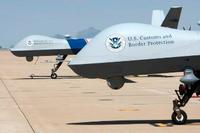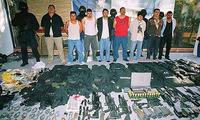-
Arizona to release immigration training plan for police officers
The tough Arizona immigration law will take effect on 29 July; Arizona officials will today release a training program designed to teach police officers to enforce the crackdown on illegal immigration without racially profiling; an hour-long video and supporting paperwork will be sent to all 170 Arizona police agencies and publicly released
-
-
U.S. has no plan to keep nuclear bomb materials from crossing border
In 2006 the George W. Bush administration announced a $1.2 billion project to deploy thousands of scanners for screening vehicles and cargo at U.S. ports to block the importation of radioactive materials that could be used to make a bomb to protect the United States; the scanners — known as the advanced spectroscopic portal (ASP) machines — proved a failure, and in February, following one setback after another, officials abandoned full-scale deployment of the machines; GAO says that the attention and resources invested in the ill-fated ASPs delayed the creation of a “global nuclear detection architecture” to protect the United States
-
-
Puerto Rico overhauls birth-certificate systems; will annul 5 million birth certificates

More than 40 percent of all passport fraud cases in the United States start with a stolen Puerto Rican birth certificate; identity thieves have targeted Puerto Ricans because Puerto Rican names provide the perfect cover for Hispanic illegal immigrants entering the United States and are worth as much as $6,000 on the black market; the documents are so valuable that drug addicts trade them for a fix; the Puerto Rican government has decided to change all that: current Puerto Rican birth certificates will no longer be valid after 30 September; between now and then, all Puerto Ricans will have to apply for more secure birth documents
-
-
Undocumented immigrants flee Arizona ahead of harsh law going into effect
Undocumented workers begin to flee Arizona ahead of Governor Jan Brewer’s immigration law going into effect; businesses suffer — and experts say the exodus could really hurt the state’s economy
-
-
More UAVs, personnel, money for U.S.-Mexico border protection

The Obama administration bolsters U.S.-Mexico border protection; the Federal Aviation Administration (FAA) approved UAV flights over the Texas border from the Big Bend to the Rio Grande Valley; after Republicans in the Senate threatened to seek funds for 6,000 National Guardsmen to stop human and drug smuggling, Obama decided to deploy 1,200 Guard members in Southwest states until more Border Patrol and Immigration and Customs Enforcement (ICE) officers could be hired and trained; the president sent his $600 million funding request to Congress earlier this week to hire 1,000 new Border Patrol agents, 160 ICE agents, 20 CBP officers, and 20 new CBP canine teams
-
-
Mexican cartels operate permanent lookout bases in Arizona to monitor U.S. law enforcement
Mexican drug cartels now maintain permanent lookout bases in strategic locations in the hills of southern Arizona from which their scouts can monitor every move made by law enforcement officials; the scouts are supplied by drivers who bring them food, water, batteries for radios — all the items they need to stay in the wilderness for a long time; “To say that this area is out of control is an understatement,” says a border patrol agent
-
-
Police chief: Cartels threaten U.S. law enforcement in Arizona

In the first public incident of its kind, Mexican drug cartels are making direct death threats to U.S. law enforcement officials in Nogales, Arizona, the police chief there says; less publicly, the drug cartels have been targeting U.S. law enforcement personnel for intimidation and assassination for sometime now; members of the cartels have even found a new way to make the task easier: using “cloned” Border Patrol vehicles; driving a Border Patrol look-alike vehicle allows the assailants to get closer to their targets without arousing suspicion
-
-
DHS looking to UAVs to bolster border security
With the future of SBINet — the ambitious but trouble-plagued virtual fence project along the U.S.-Mexico border — unclear, DHS says it is now considering expanding its UAV fleet to beef up border security
-
-
$800 million for 53-mile of border fence (it was supposed to be 655 miles)
The original plan of the Secure Border Initiative (SBINet) called for spending $833 million to build a virtual fence — a system of sophisticated sensors, cameras, and other barriers — along 655 miles of U.S.-Mexico border in Arizona, New Mexico, and a slice of Texas, at a cost of about $1.2 million per mile; Boeing, the prime contractor, used $800 million to build the system along only 53 miles of border at a cost of $15.1 million per mile; the virtual fence’s technology is now judged a failure
-
-
Border Patrol decides not to purchase a balloon to aid communication among agents
An Arizona-based company makes a balloon that carries light-weight communication gear at 60,000 to 100,000 feet above the earth, and can extend the range of two-way radios on the ground as much as 40-fold; the Border Patrol showed interest in the balloon as a means to help its agents better communicate with each other and with law enforcement in remote border areas; but Border Patrol decided not the to pursue the balloon option
-
-
GAO: Virtual border fence "unlikely to live up to expectations"
SBINet, to ambitious plan to build a fence with the most sophisticated technology along the U.S.-Mexico border, may not be the mother of all boondoggles, but it will surely compete for top honors in a competition for such a title; the Government Accountability Office has just issued a withering report about this troubled-from-the-start, never-up-to-speed project; GAO says that the designers of the virtual fence have lowered the fence’s technical standards “to the point that —-system performance will be deemed acceptable if it identifies less than 50 percent of items of interest that cross the border”; GAO also says that the project has been characterized by “decreasing scope, uncertain timing, unclear value proposition, and limited life cycle management discipline and rigor —-“
-
-
Despite warnings, sensitive components of U.S. e-Passport are assembled in Thailand
Security experts have warned about the security risks for a while now, but a U.S. government contractor is still assembling a key passport component in Thailand; the Government Printing Office (GPO) inspector general has warned the GPO lacks a basic security plan for protecting blank e-Passports from theft by terrorists, foreign spies, or counterfeiters
-
-
Video of shooting contradicts Border Patrol's claims
The Border Patrol agent who shot and killed a 15-year old Mexican boy last Monday said he was “surrounded” by rock-throwing Mexican youth; a video of the incident shows no such thing: the agent is seen without anyone near him except one Mexican boy he, the agent, had detained; the boy is on his knees near the agent; the agent is seen drawing his gun and firing in the direction of a second suspect, standing about 60 feet away from the officer — on the Mexican side of the border; the video shows the suspect running away when the agent drew and fired his gun
-
-
Mexican drug cartels smuggling illegals into U.S. create security risk, officials say
DHS has defined several countries — primarily China, but also Afghanistan, Iran, Iraq, and Pakistan — as “special interest countries”; smuggling potential terrorists and citizens of special interest countries across the U.S. border is evolving into a billion dollar industry for Mexican drug cartels, posing a significant threat to the United States
-
-
Questions about killing of 15-year old Mexican boy by U.S. Border Patrol agent
A 15-year old Mexican, Sergio Hernandez, was shot dead by a U.S. Border Patrol agent; the agent was on the U.S. side of the border, and Hernandez and his friends on the Mexican side; unnamed U.S. sources say Hernandez was a known ” juvenile smuggler,” and that in 2009 he was charged with alien smuggling; he was also on a “most wanted” list of juvenile smugglers compiled by U.S. authorities in the El Paso area; the Border Patrol says its agents came under “assaulted with rocks” by Hernandez and his friends; the Mexican government wants to know whether it was necessary to shoot a teen-ager dead for throwing rocks
-
More headlines
The long view
Social Acceptance of Immigrants Working as Politicians or Judges Is Low
Often, the dominant society develops negative attitudes towards immigrants and their descendants because their integration is too successful – and not because they are unwilling to integrate. A possible explanation for negative attitudes towards successful immigrants could be the dominant society’s fear of immigrants occupying influential and value-based occupations. This applies, for example, for immigrants working in local politics or law.
